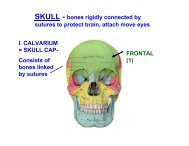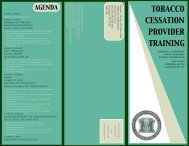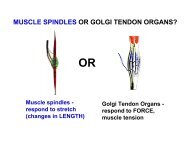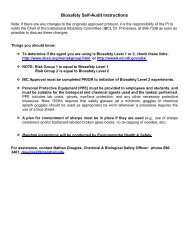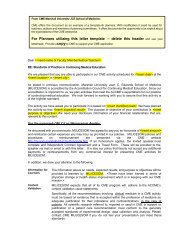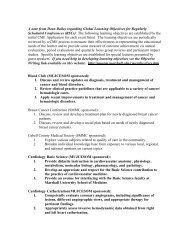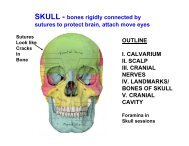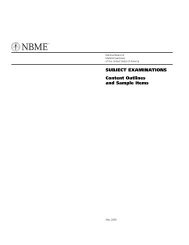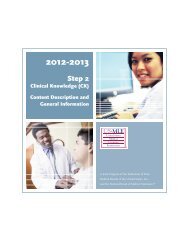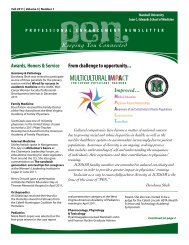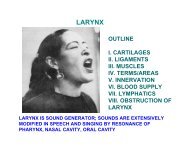FA 5 Progress Report WV-INBRE - Joan C. Edwards School of ...
FA 5 Progress Report WV-INBRE - Joan C. Edwards School of ...
FA 5 Progress Report WV-INBRE - Joan C. Edwards School of ...
- No tags were found...
You also want an ePaper? Increase the reach of your titles
YUMPU automatically turns print PDFs into web optimized ePapers that Google loves.
Program Director/Principal Investigator (Last, First, Middle): Rankin, Gary O 42during stress conditions <strong>of</strong> the model.Aim #2: To assess the effect <strong>of</strong> cold-stress on Chlamydia-induced infertility in the mouse modelThis aim was undertaken to examine the effect <strong>of</strong> stress on induction <strong>of</strong> infertility in a mouse model.Cold-stress was induced by immersing mice in cold water for 5 minutes daily for 24 days.Stressed and non-stressed groups <strong>of</strong> mice which received Depo-Provera on day 17 were infectedintravaginally with 107 IFU <strong>of</strong> C. trachomatis in a volume <strong>of</strong> 30 μl <strong>of</strong> phosphate-buffered saline(PBS) while under anesthesia. Infected mice were monitored along with cervico-vaginal swabbingat 3-day intervals during primary and secondary course <strong>of</strong> infections. After recovery fromChlamydia genital infection, all mice were mated with proven breeder male mice and monitored for19-21 days. Our results showed that exposure <strong>of</strong> mice to 24-day stress resulted in a greaterintensity <strong>of</strong> Chlamydia genital infection. The percentage <strong>of</strong> pregnant mice and the number <strong>of</strong> pupswas calculated. We noted that 10 out <strong>of</strong> 19 (52%) stressed mice were infertile compared to 2 <strong>of</strong> 19(10%) non-stress mice. Cold-water induced stress also resulted in a decreased mean number <strong>of</strong>embryos (4 to 6) in stressed mice compared to mean number <strong>of</strong> embryos (7 to 9) in non-stressedmice. These results suggest that stress may increase complications <strong>of</strong> immunopathogenesisresulting from C. trachomatis genital infection and infertility. Further experimentation is underway todetermine the effect and mechanism <strong>of</strong> stress in modulation <strong>of</strong> fertility in mice. (Abstract submittedto the General Meeting <strong>of</strong> American Society for Microbiology, San Francisco, CA, June 2012).Aim #3: To determine the effect <strong>of</strong> cold-induced stress on the histopathological changes <strong>of</strong> thegenital tract during Chlamydia infection in the mouse modelComparative analysis <strong>of</strong> the immune responses and histopathologic analysis in primary infectionversus secondary Chlamydia genital infection in stressed and non-stressed mice was initiated atthe Pathology Laboratory Service in the Medical <strong>School</strong> <strong>of</strong> Marshall University. Preliminary data <strong>of</strong>the cervical regions <strong>of</strong> mice representing stressed and non-stressed mice showed no significantdifference <strong>of</strong> hispathology. However, gross examination revealed that stressed and infected micehad fluid-filled and heavily extended uterus unlike non-stressed infected mice. Evaluation <strong>of</strong> eachanatomical site <strong>of</strong> uterine horn and oviduct for acute inflammation, chronic (lymphocytes) andplasma cells and fibrosis for chronic inflammation was initiated before the relocation <strong>of</strong> thePathology Laboratory Service in the Medical <strong>School</strong> <strong>of</strong> Marshall University.Aim #4: To elucidate the mechanism(s) by which stress increases susceptibility to Chlamydiatrachomatis genital infection in the modelOur study showed that increased susceptibility to Chlamydia infection is accompanied by multipleimmunosuppressive effects may be due to the inhibition <strong>of</strong> recruitment <strong>of</strong> T cells into genital tract,suppression <strong>of</strong> proinflammatory cytokines, chemokines by stress hormones such as noradrenaline(norepinephrine). The primary focus <strong>of</strong> this aim is to investigate how the stress hormone,norepinephrine (noradrenaline) impacts immune-mediated protection against Chlamydia trachomatisinfection. We will test whether ADR antagonists; propranolol (non-selective), or atenolol (selective)blockade affects Chlamydia clearance during genital infection. We speculate that administration <strong>of</strong>antagonists will reduce the Chlamydia burden in genital tract <strong>of</strong> stressed mice to levels similar tonon-stressed infected mice. An alternative approach, using a noradrenaline receptor knockoutmouse, is under consideration.PROTECTION AGAINST RESEARCH RISKSN 1. Will human subjects be involved next year?Y 2. Will vertebrate animals be used next year?If yes, provide the date <strong>of</strong> Institutional Animal Care and Use Committee (IACUC) approval and enclosewith transmittal.02/09/2011PHS 2590 (Rev. 06/09)Continuation Format Page



